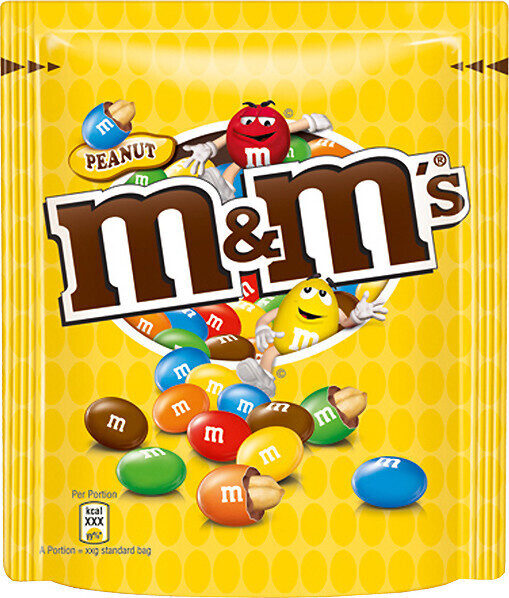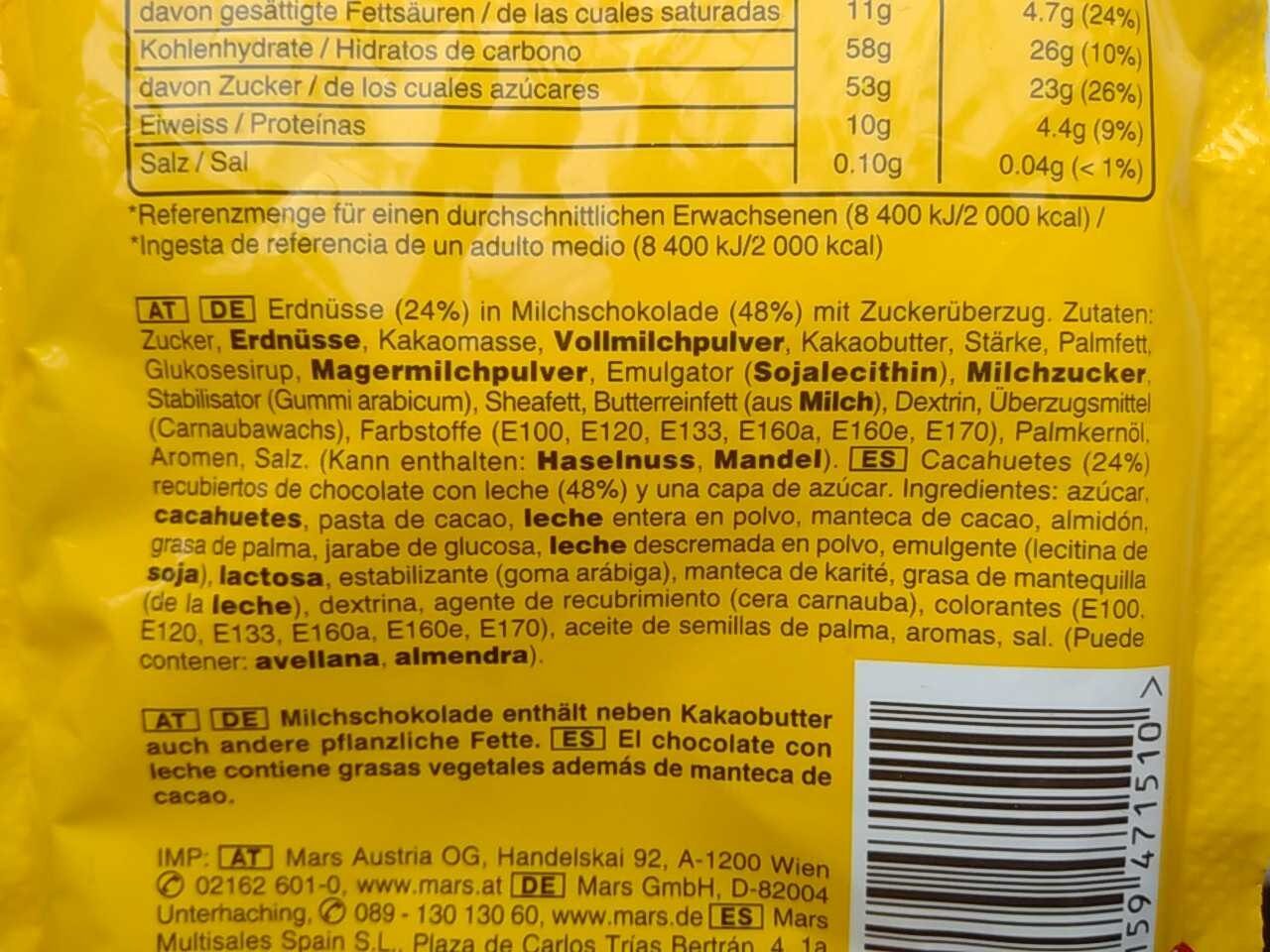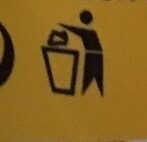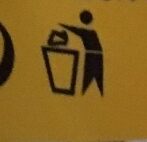Ajuda'ns a fer que la transparència alimentària sigui la norma!
Com a organització sense ànim de lucre, depenem de les vostres donacions per continuar informant els consumidors de tot el món sobre tot allò què mengen.
La revolució alimentària comença amb tu!
M&M'S - Mars - 220g
M&M'S - Mars - 220g
Aquesta pàgina del producte no està completa. Podeu ajudar a completar-la editant-la i afegint-hi més dades a partir de les fotos ja disponibles, o fent-ne més amb l'aplicació de androide o iPhone / iPad. Gràcies!
×
Codi de barres: 5000159471510 (EAN / EAN-13)
Quantitat: 220g
Empaquetament: Plàstic
Marques: Mars
Categories: Snacks, Aperitius dolços, Cacau i derivats, Llaminadures, Caramels de xocolata, Bombons, en:Chocolate covered nuts, en:Chocolate covered peanuts
Etiquetes, certificacions, premis:
Punt verd
Enllaç a la pàgina del producte en el lloc oficial del productor: http://www.mars.de
Matching with your preferences
Salut
Ingredients
-
30 ingredients
Alemany: Zucker, Erdnüsse, Kakaomasse, Vollmilchpulver, Kakaobutter, Stärke, Palmfett, Glukosesirup, Magermilchpulver, Emulgator (Sojalecithin), _Milchzucker, Stabilisator (Gummi arabicum), Sheafett, Butterreinfett (aus Milch), Dextrin, Überzugsmittel (Carnaubawachs), Farbstoffe (E100, E120, E133, E160a, E160e, E170), Palmkernöl, Aromen, Salz.Al·lèrgens: en:Milk, en:Peanuts, en:SoybeansRastres: en:Nuts
Processament d'aliments
-
Aliments ultra processats
Elements que indiquen que el producte està al grup 4 - Aliments i begudes ultraprocessats:
- Additiu: E100 - Curcumina
- Additiu: E120 - Carmí
- Additiu: E133 - Blau brillant FCF
- Additiu: E1400 - Dextrina
- Additiu: E160a - Carotè
- Additiu: E160e
- Additiu: E170 - Carbonats de calci
- Additiu: E414 - Goma aràbiga
- Additiu: E903 - Cera de carnauba
- Ingredient: Color
- Ingredient: Emulsionant
- Ingredient: Aromes
- Ingredient: Agent de recobriment
- Ingredient: Glucosa
- Ingredient: Xarop de glucosa
- Ingredient: Lactosa
Els productes alimentaris es classifiquen en 4 grups segons el seu grau de processament:
- Aliments no processats o mínimament processats
- Ingredients culinaris processats
- Aliments processats
- Aliments ultra processats
La determinació del grup es fa en funció de la categoria del producte i dels ingredients que conté.
Additius
-
E120 - Carmí
Carminic acid: Carminic acid -C22H20O13- is a red glucosidal hydroxyanthrapurin that occurs naturally in some scale insects, such as the cochineal, Armenian cochineal, and Polish cochineal. The insects produce the acid as a deterrent to predators. An aluminum salt of carminic acid is the coloring agent in carmine. Synonyms are C.I. 75470 and C.I. Natural Red 4. The chemical structure of carminic acid consists of a core anthraquinone structure linked to a glucose sugar unit. Carminic acid was first synthesized in the laboratory by organic chemists in 1991.Origen: Wikipedia (Anglès)
-
E133 - Blau brillant FCF
Brilliant Blue FCF: Brilliant Blue FCF -Blue 1- is an organic compound classified as a triarylmethane dye and a blue azo dye, reflecting its chemical structure. Known under various commercial names, it is a colorant for foods and other substances. It is denoted by E number E133 and has a color index of 42090. It has the appearance of a blue powder. It is soluble in water, and the solution has a maximum absorption at about 628 nanometers.Origen: Wikipedia (Anglès)
-
E1400 - Dextrina
Dextrin: Dextrins are a group of low-molecular-weight carbohydrates produced by the hydrolysis of starch or glycogen. Dextrins are mixtures of polymers of D-glucose units linked by α--1→4- or α--1→6- glycosidic bonds. Dextrins can be produced from starch using enzymes like amylases, as during digestion in the human body and during malting and mashing, or by applying dry heat under acidic conditions -pyrolysis or roasting-. The latter process is used industrially, and also occurs on the surface of bread during the baking process, contributing to flavor, color and crispness. Dextrins produced by heat are also known as pyrodextrins. The starch hydrolyses during roasting under acidic conditions, and short-chained starch parts partially rebranch with α--1‚6- bonds to the degraded starch molecule. See also Maillard Reaction. Dextrins are white, yellow, or brown powders that are partially or fully water-soluble, yielding optically active solutions of low viscosity. Most of them can be detected with iodine solution, giving a red coloration; one distinguishes erythrodextrin -dextrin that colours red- and achrodextrin -giving no colour-. White and yellow dextrins from starch roasted with little or no acid are called British gum.Origen: Wikipedia (Anglès)
-
E160a - Carotè
Carotene: The term carotene -also carotin, from the Latin carota, "carrot"- is used for many related unsaturated hydrocarbon substances having the formula C40Hx, which are synthesized by plants but in general cannot be made by animals -with the exception of some aphids and spider mites which acquired the synthesizing genes from fungi-. Carotenes are photosynthetic pigments important for photosynthesis. Carotenes contain no oxygen atoms. They absorb ultraviolet, violet, and blue light and scatter orange or red light, and -in low concentrations- yellow light. Carotenes are responsible for the orange colour of the carrot, for which this class of chemicals is named, and for the colours of many other fruits, vegetables and fungi -for example, sweet potatoes, chanterelle and orange cantaloupe melon-. Carotenes are also responsible for the orange -but not all of the yellow- colours in dry foliage. They also -in lower concentrations- impart the yellow coloration to milk-fat and butter. Omnivorous animal species which are relatively poor converters of coloured dietary carotenoids to colourless retinoids have yellowed-coloured body fat, as a result of the carotenoid retention from the vegetable portion of their diet. The typical yellow-coloured fat of humans and chickens is a result of fat storage of carotenes from their diets. Carotenes contribute to photosynthesis by transmitting the light energy they absorb to chlorophyll. They also protect plant tissues by helping to absorb the energy from singlet oxygen, an excited form of the oxygen molecule O2 which is formed during photosynthesis. β-Carotene is composed of two retinyl groups, and is broken down in the mucosa of the human small intestine by β-carotene 15‚15'-monooxygenase to retinal, a form of vitamin A. β-Carotene can be stored in the liver and body fat and converted to retinal as needed, thus making it a form of vitamin A for humans and some other mammals. The carotenes α-carotene and γ-carotene, due to their single retinyl group -β-ionone ring-, also have some vitamin A activity -though less than β-carotene-, as does the xanthophyll carotenoid β-cryptoxanthin. All other carotenoids, including lycopene, have no beta-ring and thus no vitamin A activity -although they may have antioxidant activity and thus biological activity in other ways-. Animal species differ greatly in their ability to convert retinyl -beta-ionone- containing carotenoids to retinals. Carnivores in general are poor converters of dietary ionone-containing carotenoids. Pure carnivores such as ferrets lack β-carotene 15‚15'-monooxygenase and cannot convert any carotenoids to retinals at all -resulting in carotenes not being a form of vitamin A for this species-; while cats can convert a trace of β-carotene to retinol, although the amount is totally insufficient for meeting their daily retinol needs.Origen: Wikipedia (Anglès)
-
E170 - Carbonats de calci
Calcium carbonate: Calcium carbonate is a chemical compound with the formula CaCO3. It is a common substance found in rocks as the minerals calcite and aragonite -most notably as limestone, which is a type of sedimentary rock consisting mainly of calcite- and is the main component of pearls and the shells of marine organisms, snails, and eggs. Calcium carbonate is the active ingredient in agricultural lime and is created when calcium ions in hard water react with carbonate ions to create limescale. It is medicinally used as a calcium supplement or as an antacid, but excessive consumption can be hazardous.Origen: Wikipedia (Anglès)
-
E414 - Goma aràbiga
Gum arabic: Gum arabic, also known as acacia gum, arabic gum, gum acacia, acacia, Senegal gum and Indian gum, and by other names, is a natural gum consisting of the hardened sap of various species of the acacia tree. Originally, gum arabic was collected from Acacia nilotica which was called the "gum arabic tree"; in the present day, gum arabic is collected from acacia species, predominantly Acacia senegal and Vachellia -Acacia- seyal; the term "gum arabic" does not indicate a particular botanical source. In a few cases so‐called "gum arabic" may not even have been collected from Acacia species, but may originate from Combretum, Albizia or some other genus. Producers harvest the gum commercially from wild trees, mostly in Sudan -80%- and throughout the Sahel, from Senegal to Somalia—though it is historically cultivated in Arabia and West Asia. Gum arabic is a complex mixture of glycoproteins and polysaccharides. It is the original source of the sugars arabinose and ribose, both of which were first discovered and isolated from it, and are named after it. Gum arabic is soluble in water. It is edible, and used primarily in the food industry as a stabilizer, with EU E number E414. Gum arabic is a key ingredient in traditional lithography and is used in printing, paint production, glue, cosmetics and various industrial applications, including viscosity control in inks and in textile industries, though less expensive materials compete with it for many of these roles. While gum arabic is now produced throughout the African Sahel, it is still harvested and used in the Middle East.Origen: Wikipedia (Anglès)
-
E903 - Cera de carnauba
Carnauba wax: Carnauba -; Portuguese: carnaúba [kaʁnɐˈubɐ]-, also called Brazil wax and palm wax, is a wax of the leaves of the palm Copernicia prunifera -Synonym: Copernicia cerifera-, a plant native to and grown only in the northeastern Brazilian states of Piauí, Ceará, Maranhão, Bahia, and Rio Grande do Norte. It is known as "queen of waxes" and in its pure state, usually comes in the form of hard yellow-brown flakes. It is obtained from the leaves of the carnauba palm by collecting and drying them, beating them to loosen the wax, then refining and bleaching the wax.Origen: Wikipedia (Anglès)
Anàlisi dels ingredients
-
Oli de palma
Ingredients que contenen oli de palma: Greix de palma, Palmist
-
No és vegà
Ingredients no vegans: Llet sencera en pols, Llet desnatada en pols, Lactosa, en:Butterfat, Llet, E120
-
No és vegetarià
Ingredients no vegetarians: E120
-
Detalls de l'anàlisi dels ingredients
de: Zucker, _Erdnüsse_, Kakaomasse, _Vollmilchpulver_, Kakaobutter, Stärke, Palmfett, Glukosesirup, _Magermilchpulver_, Emulgator (_Sojalecithin_), _Milchzucker, Stabilisator (Gummi arabicum), Sheafett, Butterreinfett (aus _Milch_), Dextrin, Überzugsmittel (Carnaubawachs), Farbstoffe (e100, e120, e133, e160a, e160e, e170), Palmkernöl, Aromen, Salz- Zucker -> en:sugar - vegan: yes - vegetarian: yes - ciqual_proxy_food_code: 31016 - percent_min: 5 - percent_max: 100
- _Erdnüsse_ -> en:peanut - vegan: yes - vegetarian: yes - ciqual_food_code: 15001 - percent_min: 0 - percent_max: 50
- Kakaomasse -> en:cocoa-paste - vegan: yes - vegetarian: yes - ciqual_proxy_food_code: 16030 - percent_min: 0 - percent_max: 33.3333333333333
- _Vollmilchpulver_ -> en:whole-milk-powder - vegan: no - vegetarian: yes - ciqual_food_code: 19021 - percent_min: 0 - percent_max: 25
- Kakaobutter -> en:cocoa-butter - vegan: yes - vegetarian: yes - ciqual_food_code: 16030 - percent_min: 0 - percent_max: 20
- Stärke -> en:starch - vegan: yes - vegetarian: yes - ciqual_proxy_food_code: 9510 - percent_min: 0 - percent_max: 16.6666666666667
- Palmfett -> en:palm-fat - vegan: yes - vegetarian: yes - from_palm_oil: yes - ciqual_proxy_food_code: 16129 - percent_min: 0 - percent_max: 14.2857142857143
- Glukosesirup -> en:glucose-syrup - vegan: yes - vegetarian: yes - ciqual_proxy_food_code: 31016 - percent_min: 0 - percent_max: 12.5
- _Magermilchpulver_ -> en:skimmed-milk-powder - vegan: no - vegetarian: yes - ciqual_food_code: 19054 - percent_min: 0 - percent_max: 11.1111111111111
- Emulgator -> en:emulsifier - percent_min: 0 - percent_max: 10
- _Sojalecithin_ -> en:soya-lecithin - vegan: yes - vegetarian: yes - ciqual_food_code: 42200 - percent_min: 0 - percent_max: 10
- _Milchzucker -> en:lactose - vegan: no - vegetarian: yes - percent_min: 0 - percent_max: 9.09090909090909
- Stabilisator -> en:stabiliser - percent_min: 0 - percent_max: 8.33333333333333
- Gummi arabicum -> en:e414 - vegan: yes - vegetarian: yes - percent_min: 0 - percent_max: 8.33333333333333
- Sheafett -> en:shea-butter - vegan: yes - vegetarian: yes - from_palm_oil: no - percent_min: 0 - percent_max: 7.69230769230769
- Butterreinfett -> en:butterfat - vegan: no - vegetarian: yes - from_palm_oil: maybe - ciqual_food_code: 16401 - percent_min: 0 - percent_max: 7.14285714285714
- aus _Milch_ -> en:milk - vegan: no - vegetarian: yes - ciqual_proxy_food_code: 19051 - percent_min: 0 - percent_max: 7.14285714285714
- Dextrin -> en:e1400 - vegan: yes - vegetarian: yes - percent_min: 0 - percent_max: 6.66666666666667
- Überzugsmittel -> en:glazing-agent - percent_min: 0 - percent_max: 6.25
- Carnaubawachs -> en:e903 - vegan: yes - vegetarian: yes - percent_min: 0 - percent_max: 6.25
- Farbstoffe -> en:colour - percent_min: 0 - percent_max: 5.88235294117647
- e100 -> en:e100 - vegan: yes - vegetarian: yes - percent_min: 0 - percent_max: 5.88235294117647
- e120 -> en:e120 - vegan: no - vegetarian: no - percent_min: 0 - percent_max: 2.94117647058824
- e133 -> en:e133 - vegan: yes - vegetarian: yes - percent_min: 0 - percent_max: 1.96078431372549
- e160a -> en:e160a - vegan: maybe - vegetarian: maybe - from_palm_oil: maybe - percent_min: 0 - percent_max: 1.47058823529412
- e160e -> en:e160e - vegan: yes - vegetarian: yes - percent_min: 0 - percent_max: 1.17647058823529
- e170 -> en:e170 - percent_min: 0 - percent_max: 0.980392156862745
- Palmkernöl -> en:palm-kernel-oil - vegan: yes - vegetarian: yes - from_palm_oil: yes - percent_min: 0 - percent_max: 5.55555555555556
- Aromen -> en:flavouring - vegan: maybe - vegetarian: maybe - percent_min: 0 - percent_max: 5
- Salz -> en:salt - vegan: yes - vegetarian: yes - ciqual_food_code: 11058 - percent_min: 0 - percent_max: 0.1
Nutrició
-
Mala qualitat nutricional
⚠ ️Atenció: la quantitat de fruita, verdura i fruits secs no s'especifica a l'etiqueta, s'ha fet una estimació a partir de la llista d'ingredients: 23Aquest producte no es considera una beguda per al càlcul de la Nutri-Score.
Punts positius: 5
- Proteïnes: 5 / 5 (valor: 10, valor arrodonit: 10)
- Fibra: 5 / 5 (valor: 9.8, valor arrodonit: 9.8)
- Fruites, verdures, fruits secs i olis de colza/nou/oliva: 0 / 5 (valor: 23.75, valor arrodonit: 23.8)
Punts negatius: 26
- Energia: 6 / 10 (valor: 2159, valor arrodonit: 2159)
- Sucres: 10 / 10 (valor: 53, valor arrodonit: 53)
- Greixos saturats: 10 / 10 (valor: 11, valor arrodonit: 11)
- Sodi: 0 / 10 (valor: 40, valor arrodonit: 40)
Els punts per proteïnes no es compten perquè els punts negatius són més o iguals a 11.
Puntuació nutricional: (26 - 5)
Nutri-Score:
-
Nivells de nutrients
-
Greix en alta quantitat (26%)
Què us cal saber- Un alt consum de greixos, especialment de greixos saturats, pot augmentar el colesterol, que augmenta el risc de patir malalties del cor.
Recomanació: Reduïu el consum de greixos i greixos saturats- Trieu productes amb menys greixos i greixos saturats.
-
Àcid gras saturat en alta quantitat (11%)
Què us cal saber- Un alt consum de greixos, especialment de greixos saturats, pot augmentar el colesterol, que augmenta el risc de patir malalties del cor.
Recomanació: Reduïu el consum de greixos i greixos saturats- Trieu productes amb menys greixos i greixos saturats.
-
Sucre en alta quantitat (53%)
Què us cal saber- Un alt consum de sucre pot provocar augment de pes i càries dental. També augmenta el risc de patir diabetis tipus 2 i malalties cardiovasculars.
Recomanació: Limitau el consum de sucre i de begudes ensucrades- Les begudes ensucrades (com ara refrescos, begudes de fruites i sucs i nèctars de fruites) s'han de limitar tant com sigui possible (no més d'1 got al dia).
- Triau productes amb menor contingut de sucre i reduïu el consum de productes amb sucres afegits.
-
Sal comuna en baixa quantitat (0.1%)
Què us cal saber- Un alt consum de sal (o sodi) pot provocar un augment de la pressió arterial, que pot augmentar el risc de patir malalties del cor i ictus.
- Moltes persones que tenen hipertensió no ho saben, ja que sovint no en tenen símptomes.
- La majoria de la gent consumeix massa sal (de 9 a 12 grams de mitjana al dia), al voltant del doble del nivell màxim d'ingesta recomanat.
Recomanació: Limitau la ingesta de sal i d'aliments rics en sal- Reduïu la sal que emprau quan cuinau, i no afegiu sal a taula.
- Limiteu el consum d'aperitius salats i trieu productes amb menor contingut de sal.
-
-
Informació nutricional
Informació nutricional Com es ven
per 100 g/100 mlCom es ven
per porció (44g)Comparat amb: en:Chocolate covered peanuts Energia 2.159 kj
(516 kcal)950 kj
(227 kcal)-3% Greix 26 g 11,4 g -20% Àcid gras saturat 11 g 4,84 g -8% Hidrats de carboni 58 g 25,5 g +36% Sucre 53 g 23,3 g +39% Fiber 9,8 g 4,31 g +97% Proteïna 10 g 4,4 g -22% Sal comuna 0,1 g 0,044 g +35% Fruits‚ vegetables‚ nuts and rapeseed‚ walnut and olive oils (estimate from ingredients list analysis) 23,75 % 23,75 %
Entorn
-
Eco-puntuació E - Impacte ambiental molt alt
El Eco-Score és una puntuació experimental que resumeix els impactes ambientals dels productes alimentaris.→ L'Eco-Score es va desenvolupar inicialment a França i s'està ampliant per a altres països europeus. La fórmula Eco-Score està subjecta a canvis, ja que es millora periòdicament per fer-la més precisa i més adequada per a cada país.Anàlisi del cicle de vida
-
Impacte mitjà dels productes de la mateixa categoria: C (Score: 42/100)
Categoria: Sugar and chocolate coated peanut
Categoria: Sugar and chocolate coated peanut
- Puntuació ambiental PEF ( petjada ambiental de l'aliment ): 0.70 (com més baixa sigui la puntuació, menor serà l'impacte)
- incloent l'impacte sobre el canvi climàtic: 9.72 kg CO₂ eq/kg del producte
Etapa Impacte Agricultura
46.3 %Processament
47.8 %Empaquetament
1.5 %Transport
3.7 %Distribució
0.7 %Consum
0.0 %
Bonificacions i punts negatius
-
Falta informació sobre l'origen dels ingredients
Punts negatius: -5
⚠ ️ L'origen dels ingredients d'aquest producte no està indicat.
Si estan indicats a l'embalatge, podeu modificar la fitxa del producte i afegir-los.
Si sou el fabricant d'aquest producte, podeu enviar-nos la informació amb la nostra plataforma gratuïta per a productors.
-
Ingredients que amenacen les espècies
Punts negatius: -10
Conté oli de palma
Els boscos tropicals d'Àsia, Àfrica i Amèrica Llatina es destrueixen per crear i ampliar les plantacions de palmera d'oli. La desforestació contribueix al canvi climàtic, i posa en perill espècies com l'orangutan, l'elefant pigmeu i el rinoceront de Sumatra.
-
Embalatge d'impacte mitjà
Punts negatius: -10
Forma Material Reciclatge Impacte Unknown Plàstic Alt ⚠ ️ La informació sobre l'embalatge d'aquest producte no és prou precisa (formes i materials exactes de tots els components de l'embalatge).⚠ ️ Per a un càlcul més precís de l'Eco-Score, podeu modificar la pàgina del producte i afegir-los.
Si sou el fabricant d'aquest producte, podeu enviar-nos la informació amb la nostra plataforma gratuïta per a productors.
Eco-Score per a aquest producte
-
Impacte per a aquest producte: E (Score: 17/100)
Producte: M&M'S - Mars - 220g
Puntuació de l'anàlisi del cicle de vida: 42
Suma de bonificacions i punts negatius: -25
Puntuació final: 17/100
-
Petjada de carboni
-
Equivalent a conduir 5.0 km en un cotxe de gasolina
972 g de CO² per cada 100 g de producte
La xifra d'emissions de carboni prové de la base de dades Agribalyse d'ADEME, per a la categoria: Sugar and chocolate coated peanut (Font: Base de dades ADEME Agribalyse)
Etapa Impacte Agricultura
29.1 %Processament
66.8 %Empaquetament
1.1 %Transport
2.8 %Distribució
0.2 %Consum
0.0 %
Empaquetament
-
Embalatge d'impacte mitjà
-
Peces d'embalatge
Unknown (Plàstic)
-
Materials d'embalatge
Material % Pes de l'embalatge Pes de l'embalatge per 100 g de producte Plàstic
-
Transport
-
Orígens dels ingredients
Falta informació sobre l'origen dels ingredients
⚠ ️ L'origen dels ingredients d'aquest producte no està indicat.
Si estan indicats a l'embalatge, podeu modificar la fitxa del producte i afegir-los.
Si sou el fabricant d'aquest producte, podeu enviar-nos la informació amb la nostra plataforma gratuïta per a productors.Add the origins of ingredients for this product Add the origins of ingredients for this product
Espècies amenaçades
-
Conté oli de palma
Fomenta la desforestació i amenaça espècies com l'orangutan
Els boscos tropicals d'Àsia, Àfrica i Amèrica Llatina es destrueixen per crear i ampliar les plantacions de palmera d'oli. La desforestació contribueix al canvi climàtic, i posa en perill espècies com l'orangutan, l'elefant pigmeu i el rinoceront de Sumatra.
Report a problem
-
Incomplete or incorrect information?
Category, labels, ingredients, allergens, nutritional information, photos etc.
If the information does not match the information on the packaging, please complete or correct it. Open Food Facts is a collaborative database, and every contribution is useful for all.
Fonts de dades
Producte afegit per openfoodfacts-contributors
Última modificació de la pàgina del producte per thaialagata.
La pàgina del producte, també editada per autorotate-bot, desan, ecoscore-impact-estimator, fluff, fredaudir8, halal-app-chakib, kiliweb, kqsf20bu, musarana, packbot, predatorix, prepperapp, yuka.V0trQ0hxUWkrY1lKdnNSbnBFL040Zk5JeUw3NVdtanZLTm8vSVE9PQ, yuka.YXZnT1BLTXgrdjB0a2NJY3dFckxvOWRUNkozeFkzcXhkTzQxSVE9PQ, yuka.ZUt3alM1d0lsUHRSc1BJMStRckgzZDU1NDRDUEJHeTVjZUFZSVE9PQ, yuka.sY2b0xO6T85zoF3NwEKvlh1OctDg_yDeFx36o1CK7_2qDYHob99pzIPaLKs, yuka.sY2b0xO6T85zoF3NwEKvlmd2asSHujjmbDXQiU-0lsWnFYfLQ8pf2YHQa6o, yukafix.












